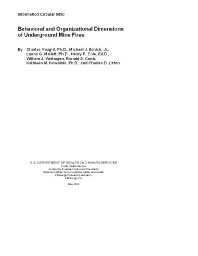Mining Publication: Behavioral and Organizational Dimensions of Underground Mine Fires
Original creation date: May 2000
How do people behave when they are trying to get out of a fire? Are escape activities different in each incident, or will most actions be predictable across events? Do persons make the same sorts of decisions whether they are responding as individuals or as group members? Because the social costs of fire-related deaths and injuries are likely to continue to rise, societal pressure for greater safety will also undoubtedly increase. There are, therefore, compelling reasons to further our understanding of action in fires. If human behavior in fire is studied scientifically and predicted according to some well-defined principles, the benefits will be significant. Design engineers could incorporate real-world findings into their plans. Equipment manufacturers could gain from insights into how their technology is actually used in fire emergencies. Safety personnel would have a better appreciation of what constitutes adequate evacuation procedures. Trainers could upgrade the content of their courses that teach escape skills. The result would be an overall improvement in the quality of fire preparedness and safety.
Authors: C Vaught, MJ Brnich, LG Mallett, HP Cole, WJ Wiehagen, RS Conti, KM Kowalski, CD Litton
Information Circular - May 2000
NIOSHTIC2 Number: 20000623
Pittsburgh, PA: U.S. Department of Health and Human Services, Public Health Service, Centers for Disease Control and Prevention, NIOSH, DHHS (NIOSH) Publication No. 2000-126, Information Circular 9450, 2000 May :1-240
See Also
- CFD Modeling of Smoke Reversal
- The Critical Ventilation Velocity in Tunnel Fires - A Computer Simulation
- Decision Making During a Simulated Mine Fire Escape
- Emergency Escape and Refuge Alternatives
- How Smoke Hinders Escape from Coal Mine Fires
- Leadership Characteristics in Escape from Three Underground Mine Fires
- Responders to Underground Mine Fires
- Technology News 494 - Expert Miner Training Video Released by NIOSH
- Technology News 497 - "You Are My Sunshine": A New Video Release From NIOSH on the Sunshine Mine Fire
- Technology News 549 - MFIRE 3.0 - NIOSH Brings MFIRE into 21st Century
- Content source: National Institute for Occupational Safety and Health, Mining Program


 ShareCompartir
ShareCompartir
